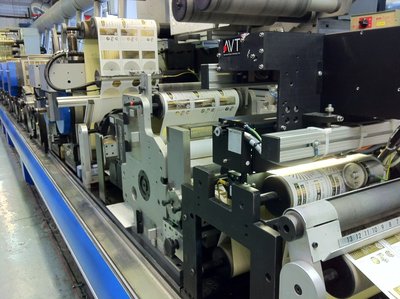AVT brings a new dimension of quality control to printing presses with improved productivity and higher profitability at Purgina, Slovakia.
‘Our latest investment has raised the profile of the company, improved the quality of labels we produce, and helped us to win new business,’ claimed Stefan Kilarsky, the general manager of Slovakian label converting company Purgina. He was referring to the installation of Advanced Vision Technology (AVT) web inspection systems on his company’s two Gallus presses, and added, ‘I believe there is no better solution for quality control, better production efficiency, and increased profitability.’
Family-run Purgina is one of the leading suppliers of self-adhesive labels in Slovakia. With a staff of 80 and turnover of €9 million, the company focuses on high end work to maximise the capability of its technology, exporting to Hungary, Poland, Austria, and the Czech Republic. Business grew rapidly in the 1990s, according Kilarsky, who runs the company with his daughter Dana and son Radovan, but there became an obvious need to improve quality – of staff, of technology and of end product. The process began with a move to new premises in Bratislava and a switch from letterpress machines in 2005, and it kick-started the move into new markets and higher quality work.
‘In the early days, we had little competition in Slovakia – now there are many companies here, and in neighbouring Czech, all competing on price. We saw our future in higher margin areas like wines and spirits, beverages, and cosmetics,’ he said. So, the company invested in Gallus presses – initially a TCS 250 offset press, fitted with a screen printing unit, embossing, hot foil stamping and flexo varnish capabilities, and more recently, a high-tech RCS 330 offset/flexo combination machine, which also has rotary screen and cold foiling capacity.
With the facility to make offset plates in-house, with an Agfa Autolith, the company had equipped itself with the capacity to produce high quality labels in short and long runs, with two complementary presses. The improved capability of the new presses, however, created a greater expectation from customers, and Kilarsky quickly became aware that quality had to be consistent to be profitable.
By 2008, the need for technology to solve the problem had become pressing, and after careful comparison of the leading contenders, Purgina opted for AVT. ‘In the end there were only two contenders, but one clear winner. The AVT Helios II system has the best interface of all, is easy to learn and operate, and in the trials we conducted, it produced the best results,’ he said. The company also invested in AVT WorkFlow for the press rewinds.
The AVT equipment ‘marks’ print errors within the roll and presents this information to the splicing table at the rewind. This is achieved via the WorkFlow link, which uses a printed barcode to synchronise the web and allows bad material to be stripped out and a perfect roll to be delivered to the customer.
Being fitted to the press, as opposed to the rewinder, the AVT technology has added an extra dimension to consistent high quality, and has made significant improvements to Purgina’s productivity and profitability. By assuring quality upstream, and reducing printed waste, the rolls delivered to the rewinders are quick to process and guarantee 100% accuracy to the customer.
This new improved label quality has allowed the company to pioneer self-adhesive labels in the Slovakian wine industry, which has switched from wet glue labels in 10 years, and also attracted interest from Hungarian and Austrian wine producers.
From being a supplier to the high volume, low value food label market, investment in technology has brought the company international status in high end label conversion, serving markets where margins are better, but standards far higher too. ‘In today’s competitive marketplace, nothing less than 100% consistent quality is good enough – and the only way to achieve that is with 100% inspection – for me, there is no better solution for increased productivity and profitability than AVT,’ concluded Mr Kilarsky.






